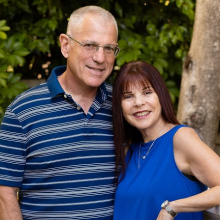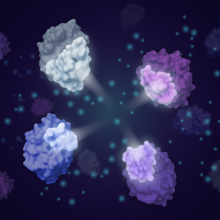Literal ray of hope
New prostate cancer therapy
Features

The number of men diagnosed with early-stage prostate cancer has dramatically increased in the last two decades as a result of widespread screening of prostate specific antigen (PSA) levels followed by biopsies and imaging.
These patients currently face a dilemma: undergo surgery or radiotherapy—which come with the unwelcome risk of impotence and incontinence—or remain under “active surveillance,” which carries the risk of disease progression. With no midway option, an increasing number of patients opt for the second alternative.
But a new therapy invented by Weizmann Institute scientists Prof. Avigdor Scherz and Prof. Yoram Salomon means that patients don’t have to choose anymore between the two opposite poles. The new therapy - called Vascular Targeted Photodynamic Therapy used in concert with Tookad Soluble® (TSVTP) - enables targeted destruction of the prostate lobe containing the cancer tissue while preserving potency, continence, and overall quality of life.
Moreover, TS-VTP can be applied at any stage of active surveillance, rather than shifting immediately to the more morbid options. It can also be repeated, with similar rates of success, and does not preclude surgery to remove the prostate or radiotherapy if cancer progresses locally.
The therapy, which was clinically developed by Steba Biotech of Luxembourg in ongoing collaboration with the scientists, was recently approved by Cofepris, the Mexican Health Authority, for medical use in patients with early-stage prostate cancer. It is currently under consideration for approval by the European Medicines Agency, which regulates drug and device approvals in 27 European countries. The U.S. Food and Drug Administration is currently reviewing approval in the U.S., where Memorial Sloan Kettering Cancer Center (MSK) in New York oversaw a multicenter trial. And four more clinical trials will open this year at MSK: for locally advanced prostate cancer and three other cancer types.
The Mexican approval comes after about 80 percent of patients evidenced a local cure in the treated prostate a year after treatment while maintaining potency and continence, and in the wake of the recent successful completion of a Phase III clinical trial of more than 400 patients in 43 medical centers across 11 European countries. The European study compared disease progression in TS-VTP treated patients and patients that underwent active surveillance.
The majority of the TS-VTP treated patients were home free in a few hours after treatment and back to normal activities a few days later—with none of the side effects usually encountered by the radically treated patients.
The therapy involves intravenously infusing patients for 10 minutes with Tookad Soluble®, which is non-toxic to both the tumor and normal tissues unless exposed to light. The infusion is immediately followed by confined tissue exposure to 22 minutes of near-infrared illumination delivered through miniscule optical fibers into the prostate tissue. The illumination triggers a cascade of events leading to the tumor’s destruction. It generates the release of short-lived oxygen and nitric oxide radicals, which rapidly destroy the blood vessels that nourish the diseased prostate tissue, leading to its destruction— all while leaving the healthy surrounding structures intact. The procedure takes about 90 minutes and the drug clears from the body rapidly (within about three to four hours).
Lessons from photosynthesis
The story of the development of TS-VTP has all the components of a great scientific success story: fruitful collaboration between different scientific disciplines, and in this case, the serendipitous turn of events that turned a chemist and a plant scientist into inventors of a cancer therapy; a commercial entity that invested in and collaborated on a highly innovative idea and remained committed through the ups and downs; a partnership with international hospitals and world-leading physicians; and enthusiastic donors who believed in the research and in the scientists driving it.
TS-VTP is based on research that took place over the course of two decades in the labs of Prof. Scherz of the Department of Plant and Environmental Sciences and Prof. Salomon from the Department of Biological Regulation—a collaboration that sprung up from a hallway conversation between two friends.
“We weren’t thinking, ‘How do we cure prostate cancer,’” recalls Prof. Scherz. “We were curious as to whether we could find a way to combine principles of photosynthetic light conversion and our knowledge about cancer for selectively eliminating cancerous tissue, while not destroying the surrounding normal structures.”
“The entire mechanism and the respective treatment protocol that we successfully developed represent a unique mode among anti-tumor treatments of which we are very proud.” says Prof. Salomon.
At the time the duo began their joint research, in the early 1990s, other types of photodynamic therapy existed, but they weren’t effective for the destruction of thick, solid tumors or else they were toxic, with patients at risk of major skin toxicities for up to 50 days. The photodynamic therapy methods were also not selective enough to effectively distinguish between the tumor and healthy tissue.
That initial hallway conversation consisted, essentially, of this: Nature has supplied photosynthesis with bacteriochlorophylls, the photosynthetic pigment of certain aquatic bacteria that draw their energy supply from sunlight. They could be the ideal molecules for generating toxic radicals deep in tissue under the right illumination, the scientists surmised. Administering these molecules to cancer patients followed by local illumination should then lead to tumor necrosis - similar to the body’s way of eliminating malfunctioning organs. And of course the therapy would have to be safe and cause few or no side effects.
Investment from industry
An early investment by Steba got them off to a start, and after attempting some 200 derivatives (molecules) of bacteriochlorophyll, the scientists finally arrived at the current drug combination. Yeda Research and Development Co. Ltd., the Weizmann Institute’s tech transfer arm, licensed rights to Steba in 1996.
The recent approval and envisioned practice will finally turn into reality the far-reaching concept that motivated Steba Biotech’s founder and owner, Raphael Harari, to join the Weizmann Institute scientists at the earliest stages of the therapy’s development. Following licensing from Yeda, Steba established a 50-person R&D facility near campus with multiple teams involved in Tookad’s development.
Says Mr. Harari, “I carefully examined this idea and strongly believed that it would succeed in offering a therapy while preserving the patient’s quality of life… Truly, I did not anticipate that it would take several hundreds of millions of dollars and two decades to be translated and approved in the clinical setting. But we believed in it.”
Profs. Scherz and Salomon are also developing photodynamic therapy to treat three non-malignant ophthalmic diseases: age-related macular degeneration, a vascular disease of the retina; keratoconus, a malfunction of the cornea, which seriously impairs vision and may lead to blindness; and early-stage myopia.
A patient speaks
One of the men enrolled in the early-stage prostate cancer trial at Memorial Sloan Kettering spoke to Weizmann Magazine about his experience, but requested anonymity.
He describes how a routine checkup in late 2009 indicated elevated PSA levels - a blood-based biomarker for prostate cancer—and a biopsy revealed a small cancerous growth. His urologist gave him two options: watch and wait, or surgery (a radical prostatectomy), though he recommended surgery. The New Jersey resident who is a computer programmer with a science background and whose wife is an epidemiologist recalls “being in a total quandary… I was worried about the potential side effects of surgery but ‘watching and waiting’ was also worrisome, even though the urologist said it was lowgrade and potentially slow-growing.”
While he was pondering his options, his primary physician referred him to Dr. Jonathan Coleman at MSK. At MSK he underwent a more advanced MRI guided biopsy that established the cancer’s grade and localization. In 2010 Dr. Coleman told him about a new clinical trial at MSK for TS-VTP, and asked if he would be interested in participating, and he underwent the procedure that summer. “I was back to work the next week. And I have had no side effects - none. At my follow-up visit after another biopsy, Dr. Coleman told me, ‘There’s no trace of cancer.’”
He adds, “Of course, like many people who have had cancer will attest, once you’ve had it you will always live with the possibility of its return hanging over your head. But the reality is that, six years later, I’m cancerfree. I feel very fortunate.”
At the bedside
Dr. Jonathan Coleman, a urologic surgeon at Memorial Sloan Kettering Cancer Center (MSK) who led the U.S. efforts in multi-center clinical trials for early and locally advanced prostate cancer, says that patients treated using the TS-VTP method “can be rendered free of identifiable cancer on biopsy with close to zero or no side effects. This therapy has the potential to be a game-changing approach to managing this kind of cancer.”
With further supporting evidence from clinical trials, he expects the method could become a front-line treatment for early-stage prostate cancer, because, he says: “We could counsel our patients: Let’s try this first and follow carefully, especially if there is very little risk involved and success rates are reasonably high. In the case where it doesn’t work, we might know within three to six months and then go to the next option, whereas treatments like radiation can take much longer to know whether the tumor is truly gone and salvage options are less feasible.”
Dr. Coleman and a team of specialists at MSK will be organizing and leading clinical trials where TS-VTP is applied to advanced prostate cancer, bladder cancer, gastroesophageal cancer, and breast cancer. More than 15 physicians and over 20 researchers from MSK and the Weizmann Institute are involved in this highly collaborative, multi-disciplinary program, which plans to spawn future studies of TS-VTP combined with complementary methods to treat both localized and disseminated diseases.
“The Thompson Family Foundation made this happen,” says Dr. Coleman (see related story). “We owe the foundation a mountain of gratitude. This model of philanthropy for supporting bench-side biomedical research and the resulting translation to clinical trials, when utilized properly, is really ideal because it enables important work to get done on a shorter timeline - and directly benefit patients that much faster,” he adds. He explained that this funding opportunity has enabled him and his colleagues to focus valuable time, resources, and effort on research in ways that are not possible with traditional funding agencies and their long timelines for approvals.
“The synergy between MSK and the Weizmann Institute has been phenomenal,” he adds, “because our strengths complement each other—outstanding basic research on the Weizmann side and powerful clinical research and patient care on our side. There is no direct competition - just a deep friendship and productive scientific endeavor.”
Prof. Avigdor Scherz is funded by The Berdie and Irvin Cohen Weizmann Institute Research Fund, Leona M. and Harry B. Helmsley Charitable Trust, Principal Anstalt, The Thompson Family Foundation, Sharon Zuckerman, Canada. Prof. Scherz is the incumbent of the Robert and Yadelle Sklare Professorial Chair in Biochemistry.
Prof. Yoram Salomon is funded by Principal Anstalt. Prof. Salomon is the incumbent of the Charles W. and Tillie K. Lubin Professorial Chair of Hormone Research.
http://www.weizmann.ac.il/Biological_Regulation/YoramSalomon

Dr. Jonathan Coleman








